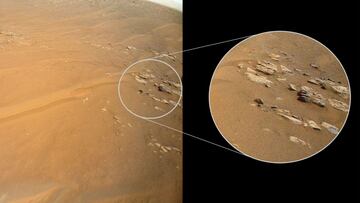NASA’s Ingenuity helicopter makes intriguing discovery on Mars
NASA’s Ingenuity helicopter has captured images showing unusual tilted rocks on Mars. The discovery could offer more information on the history of the Jezero crater.

NASA’s Ingenuity helicopter on Mars has surveyed an intriguing ridgeline near the ancient river delta in Jezero Crater. The images, which were captured on 23 April, were taken at the request of the Perseverance Mars rover science team, which wanted to examine the sloping outcrop.
“Ingenuity not only provides imagery from an aerial perspective but allows our team to be two places at once on Mars,” said Ken Farley of Caltech, Perseverance’s project scientist. “Sending the rover to survey and prospect in one location while launching the helicopter to survey another hundred meters away is a great time-saver. It can also help us explore areas the rover will never visit, as in this case.”
The images taken suggest that tilted rock layers in this area of Mars are uncommon. The ability to compare Ingenuity’s shots of the two angled ridgelines will help the team’s scientists to better understand the history of the crater floor and, perhaps the forces that were at play in this part of Jezero Crater billions of years ago.
How does Ingenuity work?
The images of the tilted rock captured by Ingenuity are from the helicopter’s scan to view the backshell and parachute that helped the Perseverance rover land on Mars. These images also have the potential to help ensure safer landings for future spacecraft, such as the Mars Sample Return Lander. The Mars Sample Return Lander is part of a multi-mission project that will bring Perseverance samples of Martian rocks, atmosphere and sediment to Earth for analysis.
Ingenuity Mars helicopter snaps amazing photos of Perseverance rover's landing gear (video) https://t.co/9Xr7TXXTze pic.twitter.com/AgIjsy0WvT
— SPACE.com (@SPACEdotcom) April 27, 2022
NASA helicopter’s 27th flight
Ingenuity started operations in April 2021, when NASA conducted the first test flight of an aircraft on another planet as part of the Mars 2020 Perseverance mission. The tiny helicopter weighs 1.8 kilograms. The images captured on 23 April was the helicopter’s 27th flight.
One year after its first trip to Mars, the helicopter had already spent a total of 46.5 minutes in the air and travelled 5,824 metres with a maximum altitude of twelve metres.
Related stories
An objective of Perseverance’s mission on Mars is astrobiology, which includes the search for signs of ancient microbial life. According to NASA.gov, the rover will characterise the planet’s geology and past climate, paving the way for human exploration of Mars, and be the first mission to collect and cache Martian rock and regolith.
Nasa engineer Elio Morillo, who was involved in the first 30 days of the mission, explained that after the five scheduled flights, the helicopter would have been left behind while Perseverance continued on its way. However, with each flight, scientists have discovered that it can follow the rover, maintain communication with it, charge its batteries and get through the freezing nights without any issues.

